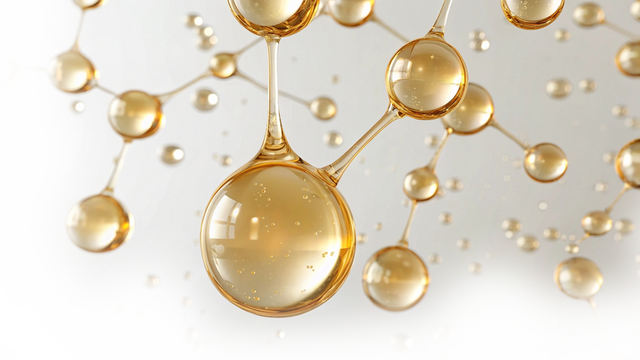
Panel discussion on...
Peptides
Emerging Trends in Peptide Use: Innovations and Applications
Consumers today recognize that beautiful skin starts with healthy skin, shifting the focus from merely reducing wrinkles to maximizing skin potential at every stage of life. In a competitive skincare market, brands must highlight distinctive active ingredients to stand out. In particular, the rise of computational tools and artificial intelligence (AI) in peptide research has spurred the development of advanced methodologies and databases that are pivotal in the exploration of these complex macromolecules. This perspective delves into integrating AI in peptide development, encompassing classifier methods, predictive systems and the avant-garde design facilitated by deep-generative models like generative adversarial networks and variational autoencoders (1).
As the focus on overall skin health and wellness grows, peptides' versatility and efficacy make them suitable for a broader range of skincare applications. This includes aspects like hydration, barrier repair and even skin brightening.
Recent trends such as longevity and the hallmarks of ageing require a holistic approach to skin health, addressing aging's root causes early enough to support well-aging (2). The pro-aging approach now includes protection from external stressors, well recognized to drive premature aging: the exposome triggers pro-inflammatory molecules and enzymes, leading to skin damage and aging signs. Specifically designed peptides can counteract this by modulating inflammatory reactions, promoting healthy aging across skin layers.
Peptide technology is still a relatively young discipline in the cosmetics industry. However, technical progress has often been driven by the pharmaceutical industry. As long as there is a need for optimized solutions, there will also be further steps. In the past two synthesis methodologies, namely, classical solution peptide synthesis (CSPS) and solid-phase peptide synthesis (SPPS) have been used. Recently liquid-phase peptide synthesis (LPPS) has become more popular. LPPS combines the advantages of CSPS and SPPS, where peptide elongation is carried out in solution and the growing peptide chain is supported on a soluble tag, which confers characteristic properties. LPPS protocols may allow the large-scale production of peptides and reduce the use of excess reagents and solvents, thus meeting the principles of green chemistry (3).
Whatever the future will be one question cannot easily be answered- The debate between targeting anti-aging with more specific peptides or multifunctional sequences is ongoing, but recent research suggests advantages to both approaches: Precision targeting or multifunctional sequences. Specific peptides can be designed to target specific pathways with minimal impact on others, reducing possible side effects or offering customized solutions. Specific sequences can also be optimized for enhanced efficacy. Multifunctional peptides, however, can simultaneously target various disease-related pathways, potentially alleviating treatment burden for consumers. Such sequences can address multiple aspects of aging, such as collagen production, skin barrier function, and protection against environmental damage. Another opportunity for customers will still be a complex of several peptides with an additive or in the best case a synergistic effect. The future of anti-aging peptide therapy lies in a balanced approach that combines the precision of specific peptides with the comprehensive benefits of multifunctional sequences (4).
Mechanisms of Action of Peptide and Market Perception
From our point of view, it is necessary to characterize the function of peptides on a molecular level. This is precisely the great advantage of defined sequences over traditional extracts, but also over peptide hydrolysates that are not fully characterized. The requirement for modern cosmetic peptides, also based on the primum price, must be to understand their mode of function. The aim of peptides is to support biological processes or to put the body in a position to carry them out. If you look at these specifications, it becomes clear that this only works if the mechanism of action is clear. Inhibiting enzymes, for example, or triggering signaling effects via membrane-bound receptors requires a clear understanding of the structure. Even when designing a sequence, knowledge of its effect is essential in order to be able to use new tools such as ML and AI. (5)
Formulation Challenges and Solutions
Today peptides are popular in skincare because they address major consumer needs without posing too great a challenge for the formulators. However, formulating effective peptide-based products challenges related to stability, efficacy, and compatibility with other active ingredients will have to be considered. Depending on the structure, peptides are sensitive to environmental factors like temperature, light, and oxygen. Hydrolysis, oxidative, and enzymatic degradation are major concerns (6). These factors could lead to accelerated degradation and reduced effectiveness. While peptide sequences that consist of L-amino acids only might face enzymatic degradation on skin the use of D- amino acid or side chain modifications will reduce this. Possible challenges in highly aqueous systems might require adjustments in water content, process and/or use of solubilizers to prevent precipitation. Adjusting pH to match the peptide’s isoelectric point minimizes charge-induced instability.
Peptides are often combined with ingredients like retinoids, AHAs, and antioxidants. However, some ingredients can destabilize peptides. For example, Ascorbic acid (Vitamin C) may degrade peptides due to its acidic pH (3-4). Careful selection and concentration balancing of complementary ingredients are crucial. Peptides like Tetradecyl Aminobutyroylvalylaminobutyric Urea Acetate work well with hydrating ingredients like hyaluronic acid. Adjusting the final formulation’s pH to accommodate both peptides and other actives is essential, with final recommended pH values ranging from 3.0 to 7.5 for some peptides or from 3.0 to 5.5 for others.
The is no clear rule for the bioavailability of peptides, however short peptides chains normally show better penetration than longer chains and the use of specific amino acids such as valine, leucine, or phenylalanine can help to enhance penetration. In addition to traditional formulation work advanced techniques may help to maintain peptide stability and enhance bioavailability. For example, Palmitoyl Tripeptide-5 can benefit from liposomal encapsulation, ensuring better skin penetration and sustained release. “Smart” delivery systems release peptides in response to specific skin conditions, offering targeted delivery. Microencapsulation, liposomal systems, and nanotechnology offer solutions. With ongoing research and innovations, peptide-based products will continue to evolve, addressing a wide range of skin concerns and becoming integral to modern skincare routines.
Sustainability and Peptides
As sustainability becomes a key focus for innovation in peptide manufacturing, applying Green Chemistry as a design principle is essential to optimizing efficacy while minimizing environmental impact.
This approach addresses key environmental challenges, from reducing waste and increased atom-economy to improving biodegradability, while also calling for suppressing hazardous solvents and persistent chemicals such as trifluoroacetic acid (TFA).
Widely used in peptide synthesis, TFA falls under a class of per-and polyfluoalkyl substances (PFAS), which have received significant attention due to their persistence in the environment and potential health risks.
In the USA, several state authorities are actively regulating and restricting PFAS, with the prohibition of cosmetics and personal care products containing PFAS set to become law in 2025 for many states.
In the EU, five national authorities (the Netherlands, Germany, Denmark, Sweden, and Norway) have prepared a PFAS restriction proposal under REACH, the chemicals regulation of the European Union (EU).
Beyond regulatory compliance, efficacy plays a crucial role in sustainability. High-performance peptides require lower concentrations in formulations, reducing carbon footprint in use and overall environmental impact. At the same time, optimizing synthesis by minimizing the number of reaction steps, reducing solvent use, and replacing CMR chemicals with safer alternatives remains essential. Prioritizing naturally derived amino acids and biodegradable structures further ensures that peptides do not persist in the environment.
With growing pressure to eliminate PFAS in cosmetic ingredients, Green Chemistry is emerging as the key design principle of more sustainable and effective peptide innovations, combining efficient manufacturing with high-performance formulations.
Panelists
References and notes
- Goles M, Daza A, Cabas-Mora G, Sarmiento-Varón L, Sepúlveda-Yañez J, Anvari-Kazemabad H, et al. Peptide-based drug discovery through artificial intelligence: towards an autonomous design of therapeutic peptides. Briefings in Bioinformatics [Internet]. 2024 May 23;25(4)
- López-Otín C, Blasco MA, Partridge L, Serrano M, Kroemer G. Hallmarks of aging: An expanding universe. Cell [Internet]. 2023 Jan 1;186(2):243–78.
- Sharma A, Kumar A, De La Torre BG, Albericio F. Liquid-Phase peptide synthesis (LPPS): a third wave for the preparation of peptides. Chemical Reviews [Internet]. 2022 Jul 11;122(16):13516–46
- R K, Kumar A, Kumar KV, Sengupta A, Kundal K, Sharma S, et al. AagingBase: a comprehensive database of anti-aging peptides. Database [Internet]. 2024 Jan 1;2024.
- Wang, L., Wang, N., Zhang, W. et al. Therapeutic peptides: current applications and future directions. Sig Transduct Target Ther 7, 48 (2022). https://doi.org/10.1038/s41392-022-00904-4
- Nugrahadi PP, Hinrichs WLJ, Frijlink HW, Schöneich C, Avanti C. Designing Formulation Strategies for Enhanced stability of therapeutic peptides in aqueous solutions: A review. Pharmaceutics [Internet]. 2023 Mar 14;15(3):935







































